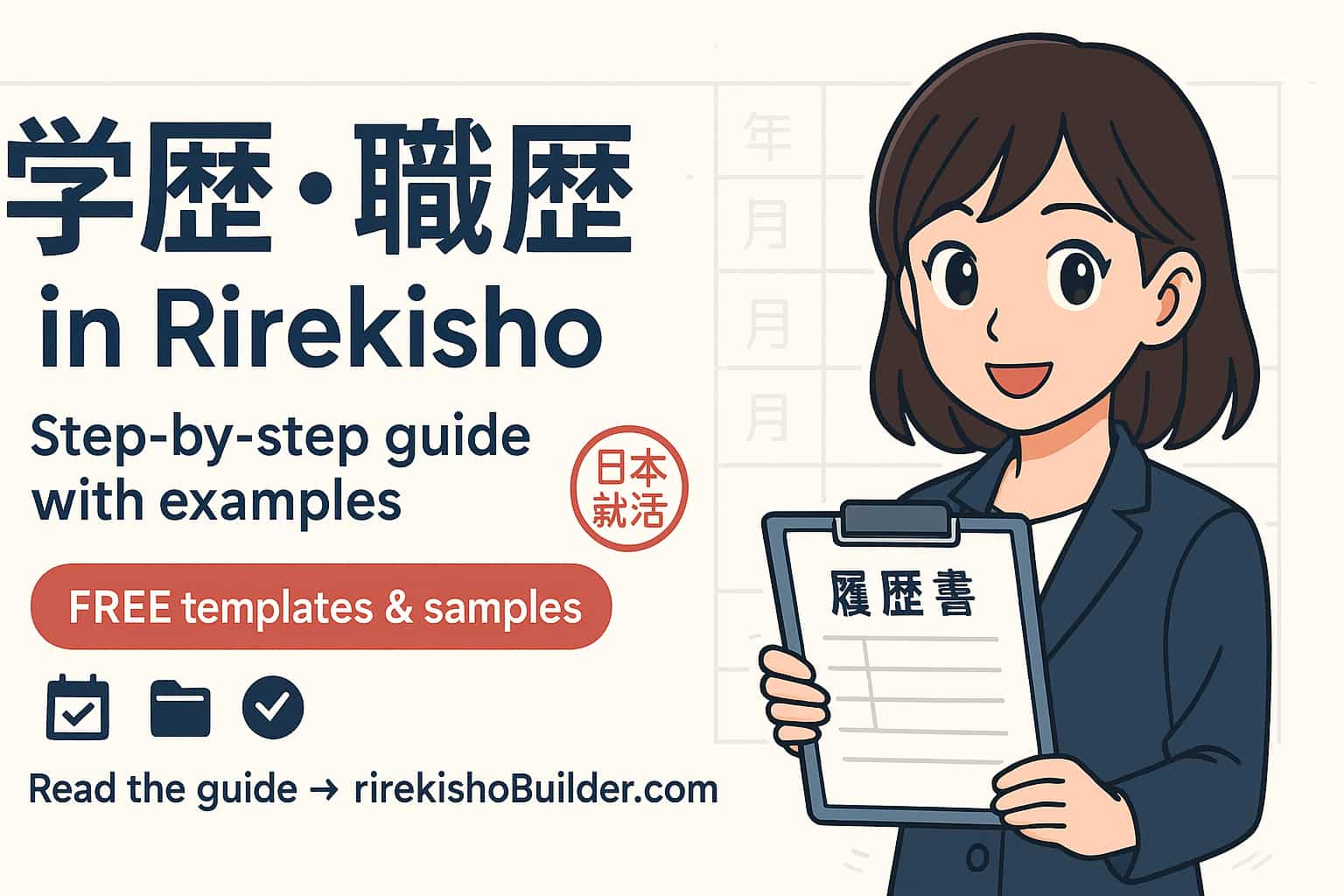How to Write the Education & Work History Section in a Japanese Rirekisho (学歴・職歴)

If you’re applying for jobs in Japan, the Education & Work History section of the Japanese resume (Rirekisho) can be confusing. In Japanese it’s called Gakureki (学歴, Education) and Shokureki (職歴, Work History). This guide walks you through it step by step with clear tables, real examples (using English school/company names), and simple explanations of the key terms like Nyūgaku (入学, enrollment), Sotsugyō (卒業, graduation), Nyūsha (入社, joined company), and Taishoku (退職, left company). By the end, you’ll know exactly what to write, where to write it, and how to make it look professional.
How the 学歴・職歴 section is laid out (simple overview)
The section is formatted as a three-column table:
- Year (年): Write only the year (e.g., 2010, 2024).
- Month (月): Always two digits (e.g., 04, 09).
- Details (内容): Write the full school/company name, followed by the correct Japanese keyword.
How to write 学歴 (Education) — with examples
Write your academic history in order, starting from high school:
| 年 | 月 | 学 歴 ・ 職 歴 (各別にまとめて書く) |
|---|---|---|
| 学歴 | ||
| 2010 | 04 | ABC High School 入学 |
| 2013 | 03 | ABC High School 卒業 |
| 2013 | 04 | XYZ University, Faculty of Economics 入学 |
| 2017 | 03 | XYZ University, Faculty of Economics 卒業 |
On mobile Or small divices Swipe left/right to see the full table.
How to write 職歴 (Work History) — with examples
After one blank row, continue with your job history. Use 入社 for joining, 退職 for leaving, and 現在に至る if you are still employed.
| 年 | 月 | 学 歴 ・ 職 歴 (各別にまとめて書く) |
|---|---|---|
| 職歴 | ||
| 2017 | 04 | Sample Corporation 入社(Sales Department 配属) |
| 2020 | 03 | Sample Corporation 退職 |
| 2020 | 04 | Test Technologies Inc. 入社(Development Department 配属) |
| 2024 | 09 | Test Technologies Inc. 退職 |
| 以上 |
On mobile Or small divices Swipe left/right to see the full table.
Page 1 or Page 2? Where to continue (real Rirekisho rules)
In a real Rirekisho, you should not leave large empty spaces. If your 学歴 (Education) section ends on the first page and there are still rows left, you have two options:
- Option A (Practical): Leave one blank row, then write 職歴 (Work History) centered in the details column, and begin your work history right away on the same page. If the work history continues onto the second page, simply continue in the same format. At the top of page 2, write 職歴 again before continuing.
- Option B (Clean Layout): If you prefer a neater separation and have only a short work history, you can finish the 学歴 section on page 1 and then start 職歴 fresh on page 2, even if rows remain unused on the first page. Both approaches are acceptable, depending on your preference and the space available.
Example: 学歴 Ends Mid-Page, Then Start 職歴
| 年 | 月 | 学 歴 ・ 職 歴 (各別にまとめて書く) |
|---|---|---|
| 学歴 | ||
| 2010 | 04 | ABC High School 入学 |
| 2013 | 03 | ABC High School 卒業 |
| 2013 | 04 | XYZ University, Faculty of Economics 入学 |
| 2017 | 03 | XYZ University, Faculty of Economics 卒業 |
| 職歴 | ||
| 2017 | 04 | Sample Corporation 入社(Sales Department 配属) |
| 2020 | 03 | Sample Corporation 退職 |
| 2020 | 04 | Test Technologies Inc. 入社(Development Department 配属) |
| 2024 | 09 | Test Technologies Inc. 退職 |
| 以上 |
On mobile Or small divices Swipe left/right to see the full table.
Key Japanese Terms and When to Use Them
-
入学 = Enrollment (school/university)
Write this when you start a new school or university. Example: “XYZ University 入学”. -
卒業 = Graduation (school/university)
Write this when you finish a school program. Example: “XYZ University 卒業”. -
入社 = Joined company
Use this when you join a company, often with department assignment. Example: “ABC Corporation 入社(Sales Department 配属)”. -
退職 = Resigned / Left company
Write this when leaving a company. Example: “ABC Corporation 退職”. -
現在に至る = Still employed / Up to present
If you are still working at your current company, write this instead of 退職. Place it at the bottom of the 職歴 section before writing 以上. -
以上 = The End
Always write this at the very end of the 職歴 (Work History) section, aligned to the right. It shows you have no more entries to add.
Writing Rules to Remember
-
Do not abbreviate school or company names.
Always write the full official name. For example, write “Tokyo University” instead of “TU”, or “ABC Corporation” instead of “ABC Corp.” -
Keep all entries in chronological order.
This means starting from the oldest (high school) and moving step by step to the most recent. Do not jump back and forth in time. -
Use either all Western years (2024) or all Japanese era years (令和6年).
Pick one format and stick with it throughout the entire resume. Mixing formats looks unprofessional. -
Leave one blank row between Education (学歴) and Work History (職歴).
This makes the separation clear and easier to read. -
Align 以上 (“The End”) to the right at the end.
Write this after your last job entry to show there is nothing more to list. Always align it to the right side of the table.
Common mistakes to avoid (save yourself a rewrite)
-
Mixing year styles.
Choose either Western years (e.g., 2024) or Japanese era (例:令和6年) and use the same style everywhere. -
Abbreviating names.
Write full official school/company names (e.g., “ABC Corporation”, not “ABC Corp.”). -
Forgetting the blank row between 学歴 and 職歴.
One empty row makes the separation clear and readable. -
Not aligning 「以上」 to the right.
Place 「以上」 at the end of 職歴, aligned right (it signals there are no more entries). -
Out-of-order entries.
Keep strict chronological order — don’t jump back in time.
Conclusion
The 学歴・職歴 section looks strict at first, but it’s actually a simple pattern: year, month, detail — in order — using the right keywords.
Follow the examples above and you’ll be fine.
Ready to try it yourself? Build your resume in minutes with our free
Create Rirekisho Now.
Start with 学歴, add 職歴, and we’ll keep the layout clean for you — including the blank row and 「以上」 at the end.
